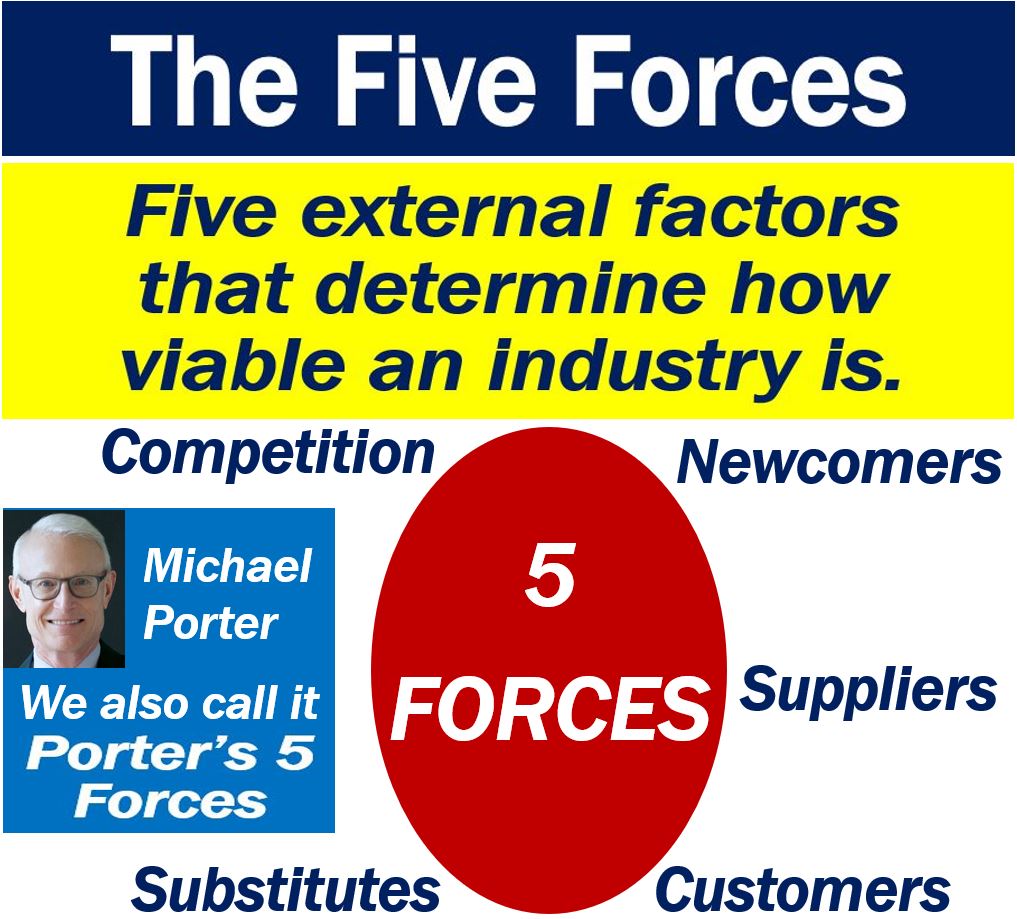The Five Forces or Porter’s Five Forces are external factors that affect an industry’s viability. The Five Forces are suppliers, buyers, substitute products, new competitors, and existing competitors. It is a framework for understanding an industry’s competitive forces at work. These forces drive how an industry’s actors divide economic value.
Michael Porter, an American academic famous for his economics and business theories, first described Porter’s Five Forces. Hence, the name.
Porter mentioned the model in his 1980 book: ‘Competitive Strategy: Techniques for Analyzing Industries and Competitors.’

Five Forces heaven and hell. A market would be paradise for a company if there were no competitors, no newcomers, lots of suppliers, lots of customers, and no substitutes. It would be hell if there were many competitors and newcomers, just one supplier, one customer, and many substitutes.
Five Forces Analysis
Five Forces Analyses can help businesses determine how attractive an industry is. They can also help companies asses how trends will affect competition within an industry and which industries to compete in.
With a Five Forces Analysis, companies can better position themselves in the marketplace. In this context, the term ‘marketplace‘ has the same meaning as ‘market‘ in its abstract sense.
According to Harvard Business School’s Institute for Strategy and Competitiveness:
“The ‘Five Forces’ is a framework for understanding the competitive forces at work in an industry, and which drive the way economic is divided among industry actors.”
We can apply Porter’s model to any segment of the economy. We apply the model to search for attractiveness and profitability.
Five Forces – I/O economics
The analysis draws from industrial organization (I/O) economics to determine how attractive an industry is. Specifically, how attractive it is for those wanting to make a profit.
An industry in which these forces reduce overall profitability is an ‘unattractive’ one.
The least attractive industry is one where ‘pure competition’ or a ‘perfect market’ exists.
Pure competition exists in a market where there are many buyers and sellers. Therefore, none of them has any significant impact on the prices of products and services.
In an industry where pure competition exists, circumstances drive all companies’ profits to normal profit levels.
The interplay of these forces can often signal the potential for innovation and disruption within a sector.
What do the Five Forces affect?
These forces affect companies’ ability to serve their customers. They also affect their ability to make a profit.
Regarding the overall industry attractiveness and changes in specific forces, Wikipedia writes:
“A change in any of the forces normally requires a business unit to re-assess the marketplace given the overall change in industry information.”
“The overall industry attractiveness does not imply that every firm in the industry will return the same profitability.”
The Five Forces
-
Competition
How many competitors are there? How can they threaten your company’s ability to function and compete effectively?
The more competitors there are, the less power your company has.
When there are very few rivals, on the other hand, your power is greater. Your chances of making big profits are also greater when competition is weak.
-
New competitors
The number of newcomers also affects your company’s power in the marketplace.
When barriers to entry are high, your company’s position is more likely to remain powerful.
Barriers to entry are hurdles or obstacles that newcomers must overcome when trying to break into a new market.
-
Suppliers
How powerful are suppliers in your industry? Can they easily drive up the prices of goods and services?
How powerful suppliers are usually depends on how many of them there are.
A supplier is relatively weak in a market with many of them. On the other hand, in a market with few or just one of them, the supplier is powerful.
-
Substitute goods or services
Substitutes pose a serious threat to a seller of a product or a provider of a service.
Substitute goods are two or more products that can replace each other. For example, Pepsi and Coke, or Crest and Colgate toothpaste are substitute goods.
If substitute goods or services exist, i.e., customers can easily switch to others, your position is relatively weak.
If, on the other hand, there are no substitutes, your position in the marketplace is strong.
-
Customers
Who has the power, you or your customers? Can your customers bring down prices?
How powerful a customer is depends on how many of them there are in the marketplace. If there is just one, then that customer is king. This is usually the case with producers of military equipment.
The easier it is for a customer to switch from one company to another, the more powerful it is.
None of the Five Forces is more powerful than the others. For some companies, one force may matter more, but overall, they all matter equally.
Example sentences
Below you can see some example sentence containing the words “the five forces,” so that you can see how we can use the term in a context:
- “Understanding ‘the Five Forces’ is essential for any business to navigate the complexities of their industry and carve out a competitive edge.”
- “By analyzing ‘the Five Forces,’ companies can anticipate changes in the market and adapt their strategies accordingly.”
- “The success of our product launch was largely due to our team’s thorough examination of ‘the Five Forces’ affecting our market segment.”
- “Experts often cite ‘the Five Forces’ as a reliable measure of an industry’s competitive intensity and profitability potential.”
- “When we considered expanding our operations, ‘the Five Forces’ analysis revealed that the entry barriers were too high to warrant the investment.”
- “The dynamics of ‘the Five Forces’ can shift rapidly with technological advancements, which is why continuous monitoring is crucial for sustained success.”
Video – What are the Five Forces?
This video, from our sister channel on YouTube – Marketing Business Network – explains what the ‘Five Market Forces’ are using simple and easy-to-understand language and examples.
